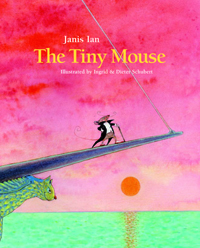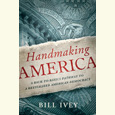Because It Makes our Hearts Glad
Grammy-winning singer-songwriter Janis Ian talks of mice and music
Janis Ian’s new picture book, The Tiny Mouse, marks the singer-songwriter’s first foray into children’s literature, although the two-time Grammy Award-winner is the author of a well-received 2008 autobiography, Society’s Child. The Tiny Mouse was inspired by Ian’s song of the same name, which was originally written as part of The Boat Project, an unusual art installation in which people from the United Kingdom donated wooden objects with personal meaning to them—from puzzles to guitars to furniture—to form a thirty-foot sailing vessel. This “floating archive” joined the flotilla celebrating Queen Elizabeth’s Diamond Jubilee and participated in the 2012 Summer Olympics in London.
 The Tiny Mouse recounts the cautionary tale of a bored, adventure-seeking mouse who stows away on a ship only to discover that the captain is a cat. The mouse quickly jumps ship, marries his rescuer, and lives happily ever after, telling stories of his shipboard adventures to his many children: “The moral of the tale is think before you sail and always keep your paws and whiskers neat,” Ian writes. “If you’re dining on a ship just be sure the room’s well lit. Always know what’s in the bowl before you eat.”
The Tiny Mouse recounts the cautionary tale of a bored, adventure-seeking mouse who stows away on a ship only to discover that the captain is a cat. The mouse quickly jumps ship, marries his rescuer, and lives happily ever after, telling stories of his shipboard adventures to his many children: “The moral of the tale is think before you sail and always keep your paws and whiskers neat,” Ian writes. “If you’re dining on a ship just be sure the room’s well lit. Always know what’s in the bowl before you eat.”
Ian recently answered questions from Chapter 16 via email prior to her appearance at the Southern Festival of Books.
Chapter 16: How did you become involved in The Boat Project?
Ian: I played Cadogan Hall in London and woke the next morning to a four-star review in the London Times. Dame Cleo Laine read it and realized I’d soon be performing at a venue she and her husband, Sir Johnny Dankworth, started called The Stables. She came to the concert, we got on very well, and next thing I knew, the head of The Stables, Monica Ferguson, was calling to invite me to be the eleventh and last songwriter for the project.
 Chapter 16: What was your inspiration for the story of The Tiny Mouse?
Chapter 16: What was your inspiration for the story of The Tiny Mouse?
Ian: Leafing through the descriptions of wooden offerings, I was struck by one—a mouse. The owner’s father was a sailor, and I wondered how many seas the tiny mouse had visited before taking up permanent residence in the attic. The great fun of writing was that I could do whatever I liked with the characters and situation. Having him dine with “platinum plates and diamond glasses,” his discovery that the ship’s captain is a cat, the final warning (“Know what’s in the bowl before you eat!”) all made for great fun in the writing.
Chapter 16: What was it like to see your words come to life through the lively and colorful illustrations of Ingrid and Dieter Schubert? Did you have any input into this process?
Ian: It was astonishing. Amazing. A whole new set of eyes. I would never have dreamed he could look like that—so debonair, so elegant, so … himself! My input was mostly confined to “ooooooh!” and “aaaaahhhh!”
Chapter 16: The Tiny Mouse includes a CD of the original song. Why was it important to you to introduce children to a musical version of the story?
Ian: It began with the song, and by including the song I hope to involve children a bit more in the reading of the book itself. My father told stories and sang to us as far back as I can remember, and it motivated my brother and me to learn reading and writing, so we could make up and write down our own. And so we could read our favorite books whenever we wanted to.
Music is inclusive. Music teaches everything from rhythm and discipline to sharing and giving. Children are growing up with talent shows on TV that promote looks, clothing, and training. They promote the abstract that you must have all of those in order to sing. That’s not true. We sing because it makes our hearts glad. I’m trying to give some music back to the people. Hence the free downloads on my site, hence including the song and a non-vocal version, hence the Tiny Mouse saying, “Make your own videos with this music!”
Chapter 16: You received your second Grammy award this year (in the Best Spoken Word Album category for Society’s Child)—almost forty years after your Grammy for “At Seventeen” in 1975. How would you compare the two experiences?
Ian: I’m a lot taller now.
Chapter 16: Your mother struggled with multiple sclerosis, and after her death you established The Pearl Foundation in her name, so far raising more than $700,000 for education. Is there a particular story that rises from this work which captures its meaning for you?
Ian: Let me just be picky here—we haven’t raised more than $700,000, we’ve given away more than $700,000. At the end of each year we give away most of what’s accumulated during the year.
Mmm. No particular story, really. Once we begin endowing a scholarship at a particular school, my wife and I try to remain very hands off. We never want to influence the school or the student just because we’re the chief bottle washers! We just want the money to go where it will do some good.
Janis Ian will discuss The Tiny Mouse at the twenty-fifth annual Southern Festival of Books, held in Nashville October 11-13, 2013. All festival events are free and open to the public.





